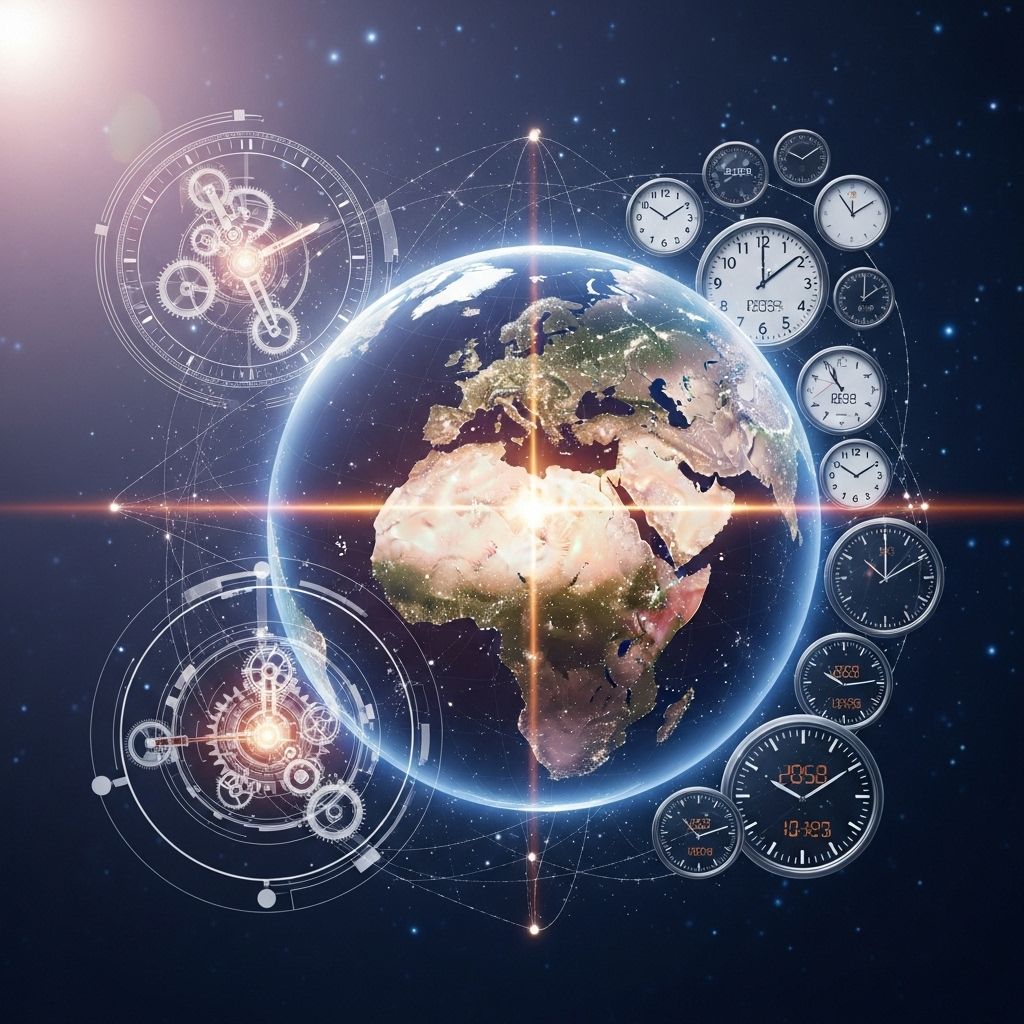Coordinated Universal Time: A Complete Guide To Global Time
Coordinated Universal Time (UTC) is the global standard that keeps our clocks in sync and our world running on time.

Image: HearthJunction Design Team
What is UTC? The World’s Timekeeping Standard
Time is a universal language, and at its heart lies Coordinated Universal Time (UTC) — the backbone of modern timekeeping. Used for everything from telling time in daily life to powering critical scientific applications and synchronizing global communications, UTC quietly underpins many aspects of our technologically connected world. But what exactly is UTC, how did it come to be, and why is it so important?
Understanding UTC: Definition and Basics
Coordinated Universal Time (UTC) is the primary time standard used worldwide to regulate clocks and time. As the successor to both Greenwich Mean Time (GMT) and Universal Time (UT), UTC ensures that everyone, everywhere, can reference a consistent, precise measure of time no matter where they are on the globe. It serves as the foundation for all civil time zones and is essential for navigation, science, global broadcasting, and the internet.
- UTC is not a time zone: It’s the standard from which all time zones across the world are calculated.
- 24-hour system: UTC is always expressed in a 24-hour format, from 00:00 to 23:59.
- Atomic precision: Its accuracy is maintained with the help of highly stable atomic clocks.
- No daylight saving time: UTC does not shift forward or backward during the year.
The Origins of Coordinated Universal Time
Prior to UTC, timekeeping relied on astronomical observations — typically based on the sun’s apparent movement. By the late 19th and early 20th centuries, Greenwich Mean Time (GMT) became the reference, marking zero degrees longitude at the Royal Observatory in Greenwich, London. However, as technology and science advanced, astronomers and physicists needed ever greater precision. Atomic clocks, introduced in the mid-20th century, provided a way to measure time independent of Earth’s rotation, which is not perfectly consistent due to various geophysical factors.
In 1960, the International Telecommunication Union (ITU) and later, in 1972, the International Bureau of Weights and Measures (BIPM), established UTC as a compromise between atomic time (International Atomic Time, TAI) and mean solar time (UT1). This hybrid system allowed for the inclusion of occasional leap seconds to keep atomic time in sync with Earth’s rotation.
How Does UTC Work?
The mechanics of UTC involve a blend of fixed, atomic-based time intervals and adjustments to match our planet’s slightly irregular motion. Here’s how it operates:
- SI Seconds: UTC divides time into days, hours, minutes, and seconds. Seconds, the smallest base SI unit here, are defined by atomic clocks using the vibrations of cesium atoms, ensuring stability and uniformity.
- Days, Hours, Minutes: Each UTC day is divided into 24 hours; each hour into 60 minutes; each minute into 60 seconds — with one important exception (see leap seconds below).
- Leap Seconds: Occasionally, to maintain UTC within about one second of mean solar time (UT1), a leap second is added or (in theory) subtracted. This keeps our clocks in step with the actual rotation of Earth.
The Role of Atomic Clocks
Atomic clocks, based on the vibration of cesium-133 or rubidium atoms, are the heart of UTC’s accuracy. These clocks are so precise they lose or gain less than a second over millions of years. An international network of laboratories maintains dozens of atomic clocks, and the data is averaged to produce a single, ultra-accurate time standard used across the globe.
Leap Seconds: Fine-Tuning Time
Earth’s rotation is not perfectly constant — it can speed up or slow down due to factors like seismic activity, tidal friction, and even melting glaciers. Over time, this means that astronomical time (based on Earth’s rotation) drifts away from atomic time. To compensate, UTC incorporates leap seconds — rare, one-second adjustments that keep UTC within one second of UT1, the time based on Earth’s actual rotation.
- Leap seconds are usually inserted at the end of June 30 or December 31.
- Since their introduction in 1972, there have been more than two dozen leap seconds added, though none have ever been subtracted.
- Decisions to add a leap second are made by the International Earth Rotation and Reference Systems Service (IERS) and are announced at least six months in advance.
The last minute of a day can have 61 seconds when a leap second is inserted; in theory, it could also have 59 seconds if the Earth speeds up, but this has not occurred.
Why Does the World Need UTC?
With international travel, finance, scientific research, and digital communications spanning the globe, a single, authoritative standard for time is essential. Here’s why UTC is so critical:
- Global Synchronization: Banks, airlines, internet servers, and scientific collaborations all depend on precisely synchronized clocks to function.
- Navigation and Satellites: GPS, spacecraft, and many modern navigation systems rely on UTC for timing and positioning accuracy.
- Scientific Research: Astronomy, particle physics, and many branches of science require internationally agreed-upon time for data collection and analysis.
- Everyday Life: From TV schedules to international phone calls, UTC underpins the systems that keep modern society coordinated.
UTC vs. Other Time Standards
UTC exists in a landscape of related time standards. Here’s how UTC compares to a few key systems:
| Standard | Definition | Use Case | Leap Seconds? |
|---|---|---|---|
| UTC | Atomic time, synced to Earth’s rotation with leap seconds | Global timekeeping, reference for all civil time | Yes |
| GMT (Greenwich Mean Time) | Based on the mean solar time at Greenwich | Pre-1972 civil time, historical reference | No (not maintained with atomic precision) |
| TAI (International Atomic Time) | Pure atomic time, continuous | Scientific applications | No (no leap seconds) |
| UT1 | Precise measure of Earth’s rotation | Astronomy, navigation | No (not atomic) |
How UTC is Maintained and Distributed
UTC is computed by the International Bureau of Weights and Measures (BIPM) in Paris, France, using data from atomic clocks located in timing laboratories around the world. Once calculated, it is distributed globally through several channels:
- Radio signals: National time services broadcast UTC signals via longwave and shortwave radio.
- Internet time servers: The Network Time Protocol (NTP) allows computers and devices worldwide to synchronize their clocks to UTC.
- Satellite systems: GPS, Galileo, and other GNSS constellations disseminate time signals based on UTC.
How Does UTC Relate to Time Zones?
Time zones across the globe are defined as offsets from UTC, written as UTC±hh:mm (for example, New York in winter is UTC-05:00, while Paris is UTC+01:00). This system allows the entire world to agree on a single baseline, while still accommodating local differences due to geography and custom.
- Most time zones are whole hours offset from UTC, but some use 30 or 45-minute increments.
- Daylight Saving Time (DST) is not observed by UTC, but is applied regionally in some countries, temporarily shifting their offset from UTC.
UTC: In Space and the Future
As humanity ventures further into space, UTC remains the choice for timing and navigation beyond our planet. The International Space Station, lunar and planetary missions, and even planned lunar settlements are all expected to use UTC or derivatives as their official time standard.
Recently, calls for a dedicated lunar time zone highlight how timekeeping may evolve as humans establish long-term presences on the Moon and beyond. Still, UTC remains the anchor for global synchronization both on Earth and throughout the solar system.
Challenges and Debates: The Leap Second Controversy
While leap seconds have kept UTC tied closely to Earth’s rotation, they pose problems for technologies that require uninterrupted, continuous time. Distributed computer systems, stock markets, and even satellite navigation can experience glitches when a leap second is inserted or removed.
- Some scientists and organizations advocate for eliminating leap seconds entirely, allowing UTC to drift from Earth’s rotation by a couple of seconds each generation.
- Others argue that maintaining close alignment with solar time is culturally and scientifically important.
The decision on the future of leap seconds remains the subject of ongoing international debate, with potential changes under consideration by the International Telecommunication Union (ITU) and other governing bodies.
Quick Facts About UTC
- UTC is maintained by averaging readings from over 400 atomic clocks in more than 70 international laboratories.
- Most UTC days last exactly 86,400 seconds, but when a leap second is added, one day is 86,401 seconds long.
- UTC is abbreviated as such in English, though the compromise acronym comes from both English (Coordinated Universal Time) and French (Temps Universel Coordonné).
- No country follows UTC as its civil time year-round, but countries like Iceland, Burkina Faso, and Ghana do not adjust their clocks from UTC.
Frequently Asked Questions (FAQs)
Q: What does UTC stand for?
A: UTC stands for Coordinated Universal Time, representing the global standard for civil timekeeping.
Q: Why are there leap seconds in UTC?
A: Leap seconds ensure that UTC remains synchronized with Earth’s rotation, which varies slightly due to natural phenomena.
Q: How does UTC differ from GMT?
A: UTC is maintained using atomic clocks and occasionally adjusted with leap seconds, whereas GMT is strictly based on Earth’s mean solar time and is not kept with atomic precision.
Q: How can I set my watch or device to UTC?
A: Most modern devices can synchronize their clocks to UTC via internet time servers (using NTP) or radio time signals.
Q: Will leap seconds always be part of UTC?
A: The future of leap seconds is under international review, and reforms may eventually eliminate them to simplify global timekeeping.
Conclusion: UTC’s Enduring Relevance
Coordinated Universal Time is a marvel of human cooperation and scientific ingenuity. By balancing the accuracy of atomic clocks with the rhythms of our rotating planet, UTC provides a stable framework for all of Earth’s diverse civilizations — and soon, perhaps, for those on the Moon and beyond. As our needs and technologies evolve, UTC will remain a touchstone, anchoring humanity to a shared understanding of time.
References
Read full bio of Anjali Sayee











